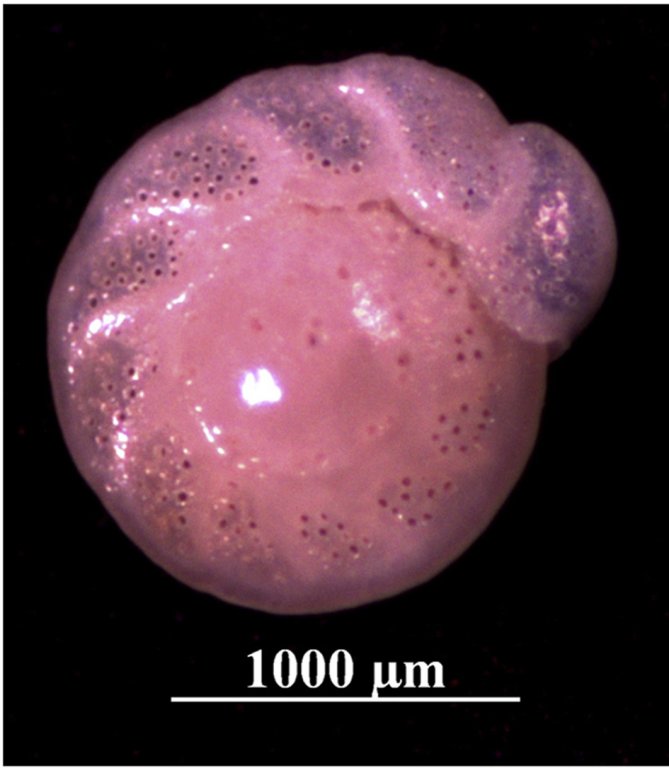Study Finds Benthic Foraminifera Recorded Deepwater Horizon Marine Oil Snow Event
– NOVEMBER 6, 2018
Researchers examined the isotopic composition of single-celled organisms (foraminifera) in seafloor sediment for evidence of the documented marine oil snow event that followed Deepwater Horizon. The shells of foraminifera collected from sediment cores between 2010 and 2012 exhibited a persistent depletion of stable carbon isotopes (δ13C 0.2 – 0.4 ‰), which indicates a shift from a natural carbon source to an oil-derived source, during and following the marine oil snow event. An increased carbon flux from the overlying water column associated with sedimentation processes and the microbial respiration of the accumulated organic carbon likely caused the shift in the type of carbon that the foraminifera incorporated, which was significantly beyond pre-spill variability. The longevity of the isotope depletion (or shift) suggests that benthic foraminiferal calcite recorded the change in the dominant available carbon source associated with the spill-related marine oil snow, providing a unique tool to assess the deposition’s subsurface spatial distribution.
The researchers published their findings in Environmental Pollution: Tracing the incorporation of carbon into benthic foraminiferal calcite following the Deepwater Horizon event.
Marine Oil Snow Sedimentation and Flocculent Accumulation (MOSSFA) is an ocean process that rapidly transports particles from surface waters to the seafloor. Following the 2010 oil spill, a MOSSFA event deposited Deepwater Horizon-derived hydrocarbons on the northeastern continental slope via a pulse of oil-mineral-biota aggregates.
This study’s researchers used geochemical tracers (stable carbon isotopes) to understand how benthic organisms incorporated oil-derived carbon and the resulting environmental impacts. The team collected sediment cores from oil-impacted sites in December 2010, February 2011, September 2011, August 2012, and August 2014 and from a control site in June 2011. As no sediment cores before 2010 were available, they used the down-core record (past seasonal fluxes) to establish pre-Deepwater Horizon sedimentary conditions. Using short-lived radioisotope geochronologies, the team established pre-spill, spill, and post-spill sediment core intervals and isolated benthic foraminifera specimens for δ13C measurement.
Stable carbon values in down-core (pre-spill) and surface (spill and post-spill) sediment from the control site were indistinguishable from each other. However, the stable carbon values were depleted in all the cores’ surface sediment from oil-impacted sites. This shift in carbon sources was evident until the measurements from sediment cores corresponding to 2013, suggesting that the 2010 spill interval was buried by subsequent sedimentation that resembled pre-spill compositions. As of 2014, the depletion was still visible below the surface (~1 cm), which is the sedimentary interval that corresponds to Deepwater Horizon.
The team’s related research suggested additional ways that benthic foraminifera can record oil deposition and the subsequent resilience, such as a decrease in foraminiferal density (Schwing et.al., 2017) and an increase in species richness and heterogeneity (Schwing et.al., 2018) respectively.
“In a broader sense, our research also holds implications for the overall oil budget and fate, carbon burial, and biomineralization of petro-carbon,” said study author Patrick Schwing. “Benthic foraminifera isotopic composition has proven to be a persistent recorder of MOSSFA and can be used in the future to delineate the extent of MOSSFA and its biological influence.”
Data are publicly available through the Gulf of Mexico Research Initiative Information and Data Cooperative (GRIIDC) at doi:10.7266/N79021PB, doi:10.7266/N7S180HN, and doi:10.7266/N7HH6H32.
The study’s authors are Patrick T. Schwing, Jeffrey P. Chanton, Isabel C. Romero, David J. Hollander, Ethan A. Goddard, Gregg R. Brooks, and Rebekka A. Larson.
By Nilde Maggie Dannreuther and Stephanie Ellis. Contact maggied@ngi.msstate.edu with questions or comments.
************
This research was made possible in part by a grant from the Gulf of Mexico Research Initiative (GoMRI) to the Center for Integrated Modeling and Analysis of Gulf Ecosystems (C-IMAGE), Center for the Integrated Modeling and Analysis of Gulf Ecosystems II (C-IMAGE II), Deepsea to Coast Connectivity in the Eastern Gulf of Mexico (DEEP-C), and the Florida Institute of Oceanography.
The Gulf of Mexico Research Initiative (GoMRI) is a 10-year independent research program established to study the effect, and the potential associated impact, of hydrocarbon releases on the environment and public health, as well as to develop improved spill mitigation, oil detection, characterization and remediation technologies. An independent and academic 20-member Research Board makes the funding and research direction decisions to ensure the intellectual quality, effectiveness and academic independence of the GoMRI research. All research data, findings and publications will be made publicly available. The program was established through a $500 million financial commitment from BP. For more information, visit https://gulfresearchinitiative.org/.
© Copyright 2010-2018 Gulf of Mexico Research Initiative (GoMRI) – All Rights Reserved. Redistribution is encouraged with acknowledgement to the Gulf of Mexico Research Initiative (GoMRI). Please credit images and/or videos as done in each article. Questions? Contact web-content editor Nilde “Maggie” Dannreuther, Northern Gulf Institute, Mississippi State University (maggied@ngi.msstate.edu).






